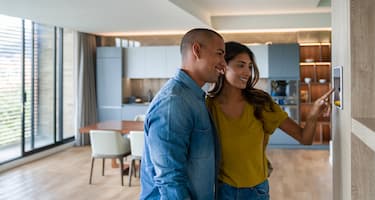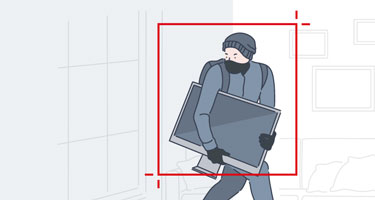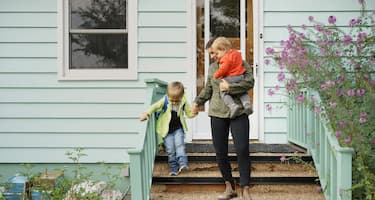In 2021-22, the number of break-ins increased from a record low in 2020-21 during the COVID-19 pandemic. [1]
We surveyed 1,003 Australians aged 18 years and over to find out about Australians’ experiences with home burglary.
We also compared these results to our Home Burglary Survey and Statistics 2022 to better understand trends from the previous year.
For insights into what Australians think about home burglary, check out our survey results below.
Quick Stats
Nearly 8% of Australian participants have experienced a break-in or attempted break-in in the last 12 months.
Almost two-thirds of participants who experienced a break-in also had packages stolen from outside their homes.
Nearly 47% of respondents who experienced a break-in would pay substantially more to rent or buy a house in a safer suburb.
Australian Home Burglary Statistics
In the last ten years, victimisation rates in break-ins have decreased.
Break-ins increased again in 2021-22 after a record low in 2020-21 of 1.7% that were likely linked to pandemic-related lockdowns. [1]
Break-In Statistics Across Australia
During the 2021-22 financial year 2% of households experienced a break-in while 2% experienced an attempted break-in. [2]
Of these, nearly 80% of households only experienced one break-in and households outside capital cities were more likely to experience an attempted break-in. [2]
Of those households who experienced a break-in, 72% reported their most recent break-in to the police, while only 43% of households reported the most recent attempted break-in to the police. [2]
Some common reasons for not reporting include:
Thinking it was too trivial or unimportant
Thinking that the police would be unable or unwilling to do anything
Nothing was stolen
Consequences of Break-Ins
Most Common Items Stolen During Break-Ins
Most Common Examples of an Attempted Break-In
Number of Affected Households |
|
|---|---|
A door or window was damaged or tampered with |
86,000 |
Someone was seen or heard trying to break in |
51,800 |
Home Burglary Survey Results^
Which items (do you think) are most likely to be taken in a home robbery?
Female |
Male |
|
|---|---|---|
Money, purse or wallet |
42.10% |
44.56% |
Personal items (such as jewellery) |
24.76% |
20.08% |
Mobile phones |
3.81% |
6.28% |
Computer equipment |
11.24% |
12.55% |
Tools |
2.67% |
2.30% |
Bicycles/Sporting equipment |
1.14% |
0.63% |
Alcohol or food |
0% |
1% |
Keys |
13.14% |
11.09% |
Other |
0.95% |
1.05% |
18-27 |
28-37 |
38-47 |
48-57 |
58-67 |
68-77 |
|
|---|---|---|---|---|---|---|
Money, purse or wallet |
42.07% |
38.89% |
44.20% |
41.98% |
45.07% |
48.51% |
Personal items (such as jewellery) |
31.71% |
24.24% |
23.76% |
21.60% |
16.90% |
14.85% |
Mobile phones |
5% |
4% |
4% |
5% |
6% |
5% |
Computer equipment |
9.15% |
14.14% |
11.60% |
12.35% |
14.08% |
11.88% |
Tools |
1.83% |
1.52% |
2.21% |
6.17% |
1.41% |
2.97% |
Bicycles/Sporting equipment |
1.83% |
1.01% |
0.00% |
0.00% |
2.11% |
0.00% |
Alcohol or food |
0.00% |
1.01% |
1.10% |
1.23% |
0.00% |
0.99% |
Keys |
7.93% |
13.13% |
12.15% |
11.73% |
11.97% |
15.84% |
Other |
0.00% |
2.02% |
0.55% |
0.00% |
2.82% |
0.00% |
NSW |
Vic |
Qld |
WA |
SA |
|
|---|---|---|---|---|---|
Money, purse or wallet |
43.93% |
36.78% |
42.23% |
47.57% |
52.86% |
Personal items (such as jewellery) |
26.79% |
26.44% |
15.05% |
20.39% |
17.14% |
Mobile phones |
6% |
5% |
5% |
5% |
1% |
Computer equipment |
12.15% |
14.18% |
7.28% |
11.65% |
12.86% |
Tools |
2.18% |
4.60% |
1.94% |
0.00% |
2.86% |
Bicycles/Sporting equipment |
0.62% |
0.38% |
1.94% |
0.97% |
1.43% |
Alcohol or food |
0.62% |
1.15% |
0.49% |
1.94% |
0.00% |
Keys |
7.79% |
10.73% |
23.79% |
11.65% |
8.57% |
Other |
0.00% |
0.77% |
1.94% |
0.97% |
2.86% |
2022 |
2024 |
|
|---|---|---|
Money, purse or wallet |
45.8% |
43.3% |
Personal items (such as jewellery) |
18.8% |
22.5% |
Mobile phones |
6.5% |
5.0% |
Computer equipment |
14.6% |
11.9% |
Tools |
3.6% |
2.5% |
Bicycles/Sporting equipment |
0.9% |
1.0% |
Alcohol or food |
1.0% |
1.0% |
Yes |
No |
|
|---|---|---|
Money, purse or wallet |
39.24% |
43.61% |
Personal items (such as jewellery) |
24.05% |
22.40% |
Mobile phones |
7.59% |
4.76% |
Computer equipment |
6.33% |
12.34% |
Tools |
1.27% |
2.60% |
Bicycles/Sporting equipment |
5.06% |
0.54% |
Alcohol or food |
1.27% |
0.76% |
Keys |
15.19% |
11.90% |
Other |
0.00% |
1.08% |
^Due to how the figures are rounded within the survey data, numbers may not add up to exactly 100%
More than 40% of Australians surveyed thought that money, purses or wallets were most likely to be stolen in a home robbery.
Nearly a quarter of respondents from Queensland thought that keys were most likely to be stolen in a home robbery.
Less than 3% of participants thought that tools and only 1% of participants thought that bicycles/sporting equipment were most likely to be stolen.
Despite these results, according to the Australian Bureau of Statistics, tools and bicycles or sporting equipment were stolen just as much as money, purses and wallets. [2]
Out of the participants who’d experienced a break-in, 5% thought bicycles/sporting equipment were most likely to be stolen in a burglary.
Have you ever had packages stolen from outside your home (e.g. deliveries left at your front door)?
Female |
Male |
|
|---|---|---|
Money, purse or wallet |
42.10% |
44.56% |
Personal items (such as jewellery) |
24.76% |
20.08% |
Mobile phones |
3.81% |
6.28% |
Computer equipment |
11.24% |
12.55% |
Tools |
2.67% |
2.30% |
Bicycles/Sporting equipment |
1.14% |
0.63% |
Alcohol or food |
0% |
1% |
Keys |
13.14% |
11.09% |
Other |
0.95% |
1.05% |
18-27 |
28-37 |
38-47 |
48-57 |
58-67 |
68-77 |
|
|---|---|---|---|---|---|---|
Yes |
30.49% |
23.23% |
18.23% |
12.35% |
14.08% |
4.95% |
No |
69.51% |
76.77% |
81.77% |
87.65% |
85.92% |
95.05% |
NSW |
Vic |
Qld |
WA |
SA |
|
|---|---|---|---|---|---|
Yes |
19.94% |
17.62% |
13.59% |
17.48% |
20.00% |
No |
80.06% |
82.38% |
86.41% |
82.52% |
80.00% |
^Due to how the figures are rounded within the survey data, numbers may not add up to exactly 100%
More than 17% of Australian participants had packages stolen from outside their homes. That’s more than double the percentage found in our Home Burglary Survey in 2022. [4]
More than 30% of 18-27 year olds had packages stolen from outside their home.
Almost two-thirds of participants who had experienced a break-in also had packages stolen from outside their homes.
Which security measures do you currently have in place at home?
Female |
Male |
|
|---|---|---|
Deadlocks |
51.81% |
59.41% |
Security screens |
51.05% |
50.84% |
Floodlights/sensor lights |
38.67% |
37.45% |
Security cameras |
40.00% |
38.70% |
Alarm system/live monitoring |
21.90% |
23.64% |
Other |
4.00% |
4.81% |
None |
11% |
10% |
18-27 |
28-37 |
38-47 |
48-57 |
58-67 |
68-75 |
|
|---|---|---|---|---|---|---|
Deadlocks |
42.68% |
44.95% |
53.59% |
61.73% |
69.01% |
64.36% |
Security screens |
40.85% |
44.44% |
48.62% |
57.41% |
61.97% |
61.39% |
Floodlights/sensor lights |
29% |
32% |
34% |
41% |
52% |
40% |
Security cameras |
45.12% |
50.00% |
43.09% |
38.27% |
38.03% |
17.82% |
Alarm system/live monitoring |
23.78% |
27.27% |
18.23% |
24.07% |
25.35% |
17.82% |
Other |
4.27% |
2.02% |
2.21% |
5.56% |
8.45% |
4.95% |
None |
14.02% |
10.10% |
12.15% |
10.49% |
3.52% |
12.87% |
NSW |
Vic |
Qld |
WA |
SA |
|
|---|---|---|---|---|---|
Deadlocks |
52.02% |
55.56% |
52.43% |
69.90% |
57.14% |
Security screens |
45.48% |
41.76% |
66.50% |
58.25% |
58.57% |
Floodlights/sensor lights |
39% |
35% |
35% |
40% |
49% |
Security cameras |
42.68% |
40.61% |
34.47% |
33.98% |
37.14% |
Alarm system/live monitoring |
23.68% |
26.82% |
14.08% |
31.07% |
24.29% |
Other |
4.67% |
1.92% |
7.28% |
2.91% |
7.14% |
None |
11.84% |
11.49% |
7.77% |
7.77% |
8.57% |
2022 |
2024 |
|
|---|---|---|
Deadlocks |
61.5% |
55.4% |
Security screens |
56.1% |
51.0% |
Floodlights/sensor lights |
43.8% |
38.1% |
Security cameras |
27.9% |
39.4% |
Alarm system/live monitoring |
18.1% |
22.7% |
None |
16.4% |
10.0% |
Yes |
No |
|
|---|---|---|
Deadlocks |
39.24% |
56.82% |
Security screens |
40.51% |
51.84% |
Floodlights/sensor lights |
37.97% |
38.10% |
Security cameras |
62.03% |
37.45% |
Alarm system/live monitoring |
32.91% |
21.86% |
Other |
3.80% |
4.44% |
None |
4% |
11% |
^Due to how the figures are rounded within the survey data, numbers may not add up to exactly 100%
More than 55% of Australians surveyed have deadlocks installed in their home for security.
This is followed by 50% of participants who have security screens and nearly 40% of participants who have both floodlights and/or sensors and security cameras installed.
Nearly 70% of 58-67 year olds have deadlocks installed in their home for security.
Almost two-thirds of participants who had experienced a break-in also had security cameras installed at their homes.
Would you pay more money to rent or buy a house that was located in a safer suburb?
^Due to how the figures are rounded within the survey data, numbers may not add up to exactly 100%
Nearly 20% of Australians would pay substantially more money to rent or buy a house that was located in a safe suburb.
Almost 60% of female participants would pay slightly more money to rent or buy a house that was in a safer suburb.
Nearly 47% of respondents who experienced a break-in would pay substantially more to rent or buy a house in a safer suburb. This is more than double the national average response.
Have you experienced a break-in, or attempted break-in within the last 12 months?
^Due to how the figures are rounded within the survey data, numbers may not add up to exactly 100%
Nearly 8% of Australian participants have experienced a break-in or attempted break-in in the last 12 months. This is up from 3.2% in our last survey in 2022. [4]
Almost 16% of 18-27-year-olds have experienced a break-in or an attempted break-in in the past 12 months.
Over 10% of Western Australian participants have experienced a break-in or an attempted break-in in the last 12 months.
What happened during the break-in?*
Female |
Male |
|
|---|---|---|
Stolen property |
56.76% |
45.24% |
Damaged property |
51.35% |
42.86% |
Confrontation with thief |
8.11% |
21.43% |
Other |
2.70% |
4.76% |
None of the above |
13.51% |
11.90% |
18-27 |
28-37 |
38-47 |
48-57 |
|
|---|---|---|---|---|
Stolen property |
50.00% |
52.63% |
63.64% |
30.77% |
Damaged property |
61.54% |
47.37% |
27.27% |
30.77% |
Confrontation with thief |
23.08% |
10.53% |
0.00% |
15.38% |
Other |
3.85% |
5.26% |
0.00% |
7.69% |
None of the above |
3.85% |
15.79% |
18.18% |
23.08% |
NSW |
Vic |
Qld |
WA |
|
|---|---|---|---|---|
Stolen property |
59.26% |
47.62% |
46.15% |
54.55% |
Damaged property |
44.44% |
52.38% |
46.15% |
45.45% |
Confrontation with thief |
11.11% |
0.00% |
30.77% |
18.18% |
Other |
7.41% |
4.76% |
0.00% |
0.00% |
None of the above |
3.70% |
19.05% |
30.77% |
9.09% |
^Due to how the figures are rounded within the survey data, numbers may not add up to exactly 100%.
*Results only include participants who experienced a break-in during the last 12 months.
Of those who’ve experienced a break-in in the past year, more than half had their property stolen and nearly 47% of participants also had damaged property.
Females were more likely to have property stolen, while males were more likely to have a confrontation with the thief.
Almost two-thirds of 18-27 year olds had their property damaged and more than 23% of this age group confronted the thief during the break-in.
What did you do after the break-in?*
Female |
Male |
|
|---|---|---|
Added/changed locks to doors and/or windows |
32.43% |
52.38% |
Added/changed gates/fences around the property |
27.03% |
38.10% |
Added/changed security screens on doors and/or windows |
21.62% |
35.71% |
Added internal lights on timers |
16.22% |
23.81% |
Added security cameras/alarm systems |
37.84% |
26.19% |
Added floodlights |
16.22% |
21.43% |
Moved house |
5% |
0% |
Took out a new insurance policy for my home |
8.11% |
4.76% |
None of the above. |
13.51% |
11.90% |
18-27 |
28-37 |
38-47 |
48-57 |
|
|---|---|---|---|---|
Added/changed locks to doors and/or windows |
46.15% |
36.84% |
27.27% |
46.15% |
Added/changed gates/fences around the property |
42.31% |
31.58% |
18.18% |
23.08% |
Added/changed security screens on doors and/or windows |
27% |
37% |
27% |
23% |
Added internal lights on timers |
34.62% |
15.79% |
18.18% |
15.38% |
Added security cameras/alarm systems |
19.23% |
52.63% |
36.36% |
15.38% |
Added floodlights |
11.54% |
21.05% |
18.18% |
30.77% |
Moved house |
3.85% |
0.00% |
9.09% |
0.00% |
Took out a new insurance policy for my home |
0.00% |
15.79% |
9.09% |
0.00% |
None of the above. |
7.69% |
10.53% |
18.18% |
23.08% |
NSW |
Vic |
Qld |
WA |
|
|---|---|---|---|---|
Added/changed locks to doors and/or windows |
37.04% |
28.57% |
53.85% |
72.73% |
Added/changed gates/fences around the property |
25.93% |
42.86% |
30.77% |
27.27% |
Added/changed security screens on doors and/or windows |
37% |
19% |
38% |
18% |
Added internal lights on timers |
18.52% |
19.05% |
23.08% |
36.36% |
Added security cameras/alarm systems |
37.04% |
38.10% |
30.77% |
9.09% |
Added floodlights |
18.52% |
28.57% |
7.69% |
18.18% |
Moved house |
0.00% |
0.00% |
7.69% |
9.09% |
Took out a new insurance policy for my home |
7.41% |
4.76% |
0.00% |
9.09% |
None of the above. |
14.81% |
9.52% |
15.38% |
9.09% |
2022 |
2024 |
|
|---|---|---|
Added/changed locks to doors and/or windows |
57.7% |
43.0% |
Added/changed gates/fences around the property |
42.3% |
32.9% |
Added/changed security screens on doors and/or windows |
30.8% |
29.1% |
Added internal lights on timers |
15.4% |
20.3% |
Added security cameras/alarm systems |
26.9% |
31.7% |
Added floodlights |
19.2% |
19.0% |
Moved house |
19.2% |
3.0% |
Took out a new insurance policy for my home |
11.5% |
6.0% |
None of the above. |
19.2% |
13.0% |
^Due to how the figures are rounded within the survey data, numbers may not add up to exactly 100%.
*Results only include participants who experienced a break-in during the last 12 months.
After the break-in, 43% of Australians added or changed locks on doors and/or windows.
Nearly 16% of 28-37-year-olds took out a new insurance policy for their home after the break-in.
In 2024, more participants added security cameras/alarm systems, than in 2022.
Did your insurance cover damage and/or losses from the break-in?*
^Due to how the figures are rounded within the survey data, numbers may not add up to exactly 100%.
*Results only include participants who experienced a break-in during the last 12 months.
Nearly 47% of Australian respondents who experienced a break-in in the past year were covered by insurance for damage and/or losses from the break-in and received some level of payment.
More than two-thirds of 38-47-year-old respondents had insurance, but didn’t claim, or didn’t receive a payment.
In 2024, there was a small decrease in Australians who were covered and received some level of payment compared to 2022.
Some Australians may not know that Home Insurance not only covers your house and personal possessions against loss or damage caused by natural disasters including storms and fires but also theft and attempted theft.
Key Takeaways
More than 1 in 2 Australians have deadlocks installed in their homes
Deadlocks continue to be the most sought-after security method with more than 55% of Australians surveyed installing deadlocks in their homes. Older respondents aged 58-67 were also most likely to install deadlocks for security reasons.
And for those respondents who hadn’t experienced a break-in, 57% had deadlocks installed as a pre-emptive security measure.
The percentage of Australians who’ve had packages stolen doubled
In 2024, more than 17% of Australian participants had packages stolen from outside their homes. Almost two-thirds of participants who had experienced a break-in also had packages stolen from outside their homes.
According to Neighbourhood Watch, more than a million parcels are reported stolen in Australia each year and this is predicted to rise. [3]
Most Australians are looking to live in safer suburbs
Nearly 20% of Australians would pay substantially more money to rent or buy a house that was located in a safer suburb. And for those who haven’t experienced a break-in, nearly two-thirds of them would pay slightly more.






